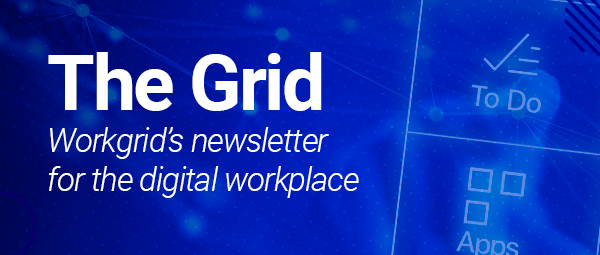The role of internal communications and the intranet in your digital workplace strategy
While there’s a lot of well-deserved high-fiving about how quickly technology was deployed to enable entire organizations to work remotely, there’s an unsung corporate hero of the pandemic and that’s internal communications.
A global crisis was dropped in the laps of these teams and their response was impressive. They deployed crisis communication plans with the speed and efficiency of the SWAT teams they had become, keeping employees informed, helping them feel safe, and delivering the need-to-know information that kept businesses running.
![[asset] crisis-comms-mckinsey](https://images.ctfassets.net/z7p73u8c0thn/4JY7HnVeeW7kEcA6vhJnuZ/370727747f368047a0ac4d4e3a4276be/crisis-comms-mckinsey.png?w=655&h=644&q=60&fm=png&bg=transparent)
But that job isn't over.
As businesses respond to the long-term changes affecting the workplace (not to mention work itself), the role of internal communications processionals will only grow in demand and necessity. Their skills will be need to help employees navigate the return to work, keep the workforce engaged despite a likely hybrid work model, and effectively communicate all the changes that will take place.
The intranet can be a valuable tool to help achieve these objectives. But those benefits will only come if expectations are adjusted about the role the intranet can - and should - play in the overall digital workplace strategy.
Instead of thinking of it as the focal point of the digital workplace, the intranet should be viewed as a single touchpoint among many for providing access to what employees need. It's employees' needs that should take center stage, with the intranet service as a vital channel for meeting those needs.
Modernizing communications with the intranet: top questions answered
The idea of using the intranet to address employee need, modernizing communication and collaboration, is something Step Two's James Robertson discussed in a recent CMSWire article, "Advancing the Digital Maturity of Internal Communications."
![[asset] StepTwoDigitalMaturityModel](https://images.ctfassets.net/z7p73u8c0thn/3TtyTELHH8dMlGGwlTPNYi/ba38fea58f5e47de885a55abc7cf4cca/StepTwoDigitalMaturityModel.jpg?w=681&h=394&fl=progressive&q=60&fm=jpg&bg=transparent)
In this piece he poses a number of questions communications professionals will have to ask themselves, such as:
What role should the intranet be playing in internal communications?
What communications functionality should the intranet provide?
How should internal communications align with shifts to new ways of working?
How do we ensure that all employees are reached at the same time?
Let's take a look at these questions in depth...
The role of a modern intranet
Question 1: What role should the intranet be playing in internal communications?
The intranet is often referred to as the front door of the enterprise, but in a digital workplace setting, using an analogy of an anchor store might be more fitting.
In retail, the “anchor store” is a considerably larger, bigger named tenant in a shopping mall or plaza. With their broad appeal, they’re intended to attract a significant cross-section of the shopping public, therefore making the other smaller stores around it “cooler by association.” Your intranet can have that kind of an impact on the digital workplace. If done well, it can provide tons of stand-alone value as the primary source for company news, crisis communication, philanthropic endeavors, diversity, equity and inclusion initiatives, and much more.
In order to effectively drive traffic to the intranet, however and give communications a chance to rise above the rest of the digital noise, it needs to be effectively designed, using integrations to combine content with transactions so everything employees need to know and do is centrally located. The goal is to give employees compelling reasons to visit the intranet. Do that and they will, by default, see your communications.
![[asset] nordstrom](https://images.ctfassets.net/z7p73u8c0thn/5wnVNjEf7sBiKAeHVqJ5H0/7d2354015ef55e25735aa048a86776df/nordstrom.png?w=450&h=300&q=60&fm=png&bg=transparent)
Without anchor stores like Nordstrom and Macy’s, smaller boutique stores like “Perfume Plus,” “Collectibles Forever,” and “Anna’s Linens” would struggle to achieve attention on their own.
So how would that work? Let’s look at some examples, using the anchor store analogy as the framework.
For the intranet to truly serve as the anchor store in your digital workplace, making corporate applications and line of business systems around it “cooler” by association, it’s not enough to find a link that simply pushes you to another location to complete a task. Instead, it should drive engagement and increase stickiness by enabling employees to actually complete the task itself.
That’s what a Fortune 500 energy company wanted to accomplish when they selected Workgrid to run on top of their new SharePoint intranet. By leveraging Workgrid’s integration catalog, they were able to deliver targeted resources like pay information, ITSM ticketing, time-off balances, expense approvals, and employee performance journeys right to their intranet – a use of integrations and level of personalization that would be too time-consuming and complex to deliver by either buying or building an intranet.
![[asset] to-do-intranet-notifications](https://images.ctfassets.net/z7p73u8c0thn/7ejSGEQ4r64gTn1XLFoDKY/583ea2dce00f249cdf3841b6e7f84012/to-do-intranet-notifications.png?w=641&h=450&q=60&fm=png&bg=transparent)
Workgrid makes it easy for employees to consume information and take action on important, often time sensitive tasks, right from the intranet.
To be clear, the goal wasn’t to recreate the underlying source systems for those experiences. Instead, the organization sought to elevate the moments inside those systems that mattered most to their employees, delivering tasks and approvals at the right time and with the right level of urgency Those associated systems are now in the “cooler by association” category because they’re easily accessible from the new, modern intranet. And the best part, since the intranet is an ongoing project of continual improvement, Workgrid also makes it easy to continue refining the intranet experience over time, adding other catalog connectors or creating unique no/low code business applications that enhance EX across multiple systems and channels.
Effective communications and the intranet
Question 2: What communications functionality should the intranet provide?
On the surface, this seems like an easy enough question to answer: the most critical purpose the intranet should serve is to provide employees with the information they need to know, right? But it isn’t that simple. For one thing, email has tried to fill that function and it’s been to the detriment of every employee’s productivity, with workers losing an average of 2.6 hours every day to the chaos that is the email inbox.
Ultimately, organizations that exhibit high levels of digital maturity make sure their intranets have the necessary functionality to deliver just the right information to the right employees at the right time. That means providing unified activity streams, along with personalized and targeted newsfeeds, to enable employees to have a single location for everything they need to know and take action on.
![[asset] Intranet Campaign Homepage](https://images.ctfassets.net/z7p73u8c0thn/5JOwd1Mpk6eWJJ6XhMwEjE/fb2f599cb3ae99e002d8d295ac562d93/Intranet_Campaign_Homepage.png?w=650&h=680&q=60&fm=png&bg=transparent)
Driving traffic to the intranet requires creating an experience that’s valuable for employees. Mixing targeted, personalized information with the transaction tasks that need their attention is a great way to do this.
Adapting to the new ways of working
Question 3: How should internal communications align with shifts to new ways of working?
Internal comms professionals are going to have to work smarter in order to keep employees informed, engaged, and productive in this new way of work.
In the case of the Fortune 500 energy company I referenced above, strategic partnerships have been a way to do just that.
While they had a solid technology ecosystem in place, they wanted to advance their people-centric mission and provide employees with a modern, intelligent experience for getting work done. Workgrid was able to help them achieve that goal, tying together all of the company’s mission-critical systems, like WorkDay, O365, ServiceNow, SAP Concur, and SAP Ariba, giving people centralized access to the tasks, information, and resources they need to be effective and engaged. Our digital assistant acts as an integration layer for their new intranet, abstracting communications, notifications, tasks, and data from core enterprise systems throughout the organization, providing employees with a personalized, contextual digital experience and a centralized location to access everything they need to know and do.
![[gif] intranet layer gif](http://images.ctfassets.net/z7p73u8c0thn/1v9fVUcYemDNwoyedT32kc/afbf9fcee3777a31eece3fb754bcae58/Intranet_Layer_.gif)
By providing employees with easy access to everything they need to know and do, creating a personalized experience that simplifies the work day, Workgrid transforms the intranet into an integral part of digital workplace strategy.
Questioning long-standing paradigms will also be key to aligning internal communications with the new ways of working.
For example, many believe the solution to their intranet problems is to either build or buy a new one from an intranet vendor. But this isn't the case. There is a third, underutilized option - a way to enhance your intranet - without replacing your existing intranet platform.
![[asset] HR Integrations and Notifications](https://images.ctfassets.net/z7p73u8c0thn/6AqzO07U9qUgBrYbneAVDF/2c176bb8798031b9b833aec2b58b49de/HR-Smart-Notifications-Example.png?w=1200&h=662&q=60&fm=png&bg=transparent)
Workgrid integrates with any existing intranet or employee portal to give every worker centralized access to everything they need to know and take action on.
This was the approach Liberty Mutual Insurance took when they decided to modernize their intranet to provide employees with the same ease-of-use experience they have in the broader technology world. By layering Workgrid on top of their intranet to deliver a unified activity stream, personalized and targeted newsfeed, and to simplify access to key enterprise systems, Liberty Mutual was able to advance their digital workplace with benefits like:
Streamlined workflows that accelerate decision making by consolidating approvals into a single experience.
70% fewer clicks with one-click access to popular employee data such as payroll, time-off balances, organization chats, etc.
Improved front-line engagement with front-line workers now having easy access to corporate communications and data from multiple systems.
40% increase in click-thru rates, with employees no longer missing important alerts.
Modernization of existing IT applications, revitalizing employee interactions with cumbersome legacy systems that lacked mobile support, without replacing or rebuilding.
![[asset] LibertyBenefits with Workgrid](https://images.ctfassets.net/z7p73u8c0thn/6ovlhC4ROPMRBHkTQ2BiOn/9878f98e53ba041ae44fa68c677f03d5/LibertyBenefits.jfif?w=315&h=344&fl=progressive&q=60&fm=jpg&bg=transparent)
The benefits Liberty Mutual achieved through the implementation of Workgrid were measurable and ongoing.
Multi-channel, multi-directional communications to reach all employees
Question 4: How do we ensure that all employees are reached at the same time?
I’d like to deviate from James’s narrative here to ask a slightly different question, one that I think leads to a more effective employee communication strategy. The question is, “How do you create an experience that’s consistent across employee types?"
Parity of experience is what’s truly important when it comes to making sure every employee, from the CEO to frontline workers and even part-time interns, have the information they need to work effectively. To be clear, this doesn’t mean that every employee gets every communication to make sure no one misses anything. Deluging workers with information like that is the fastest way to ensure communications get ignored. Instead, parity in this case refers to the nuanced approach of only sending employees information that’s relevant to them, in a way that’s closely aligned with how – and where - they prefer to work, whether that’s in a line-of-business application, on the intranet, via mobile, etc.
A recent example with one of our manufacturing customers highlights this principle perfectly. The company had an issue that halted production of one of their best producing lines. Frontline employees at that organization didn't need an update about that issue because they were experiencing it in real time. Senior leadership did need to know, however, so three quick phone calls were made to alert the C-level executives who needed the information as soon as possible. That's the level of responsiveness and audience targeting that's necessary to ensure communication plans are executed as effectively as possible across the entire enterprise.
There's another great example with a retail customer of ours, an Aroma Joe's franchisee with four locations and 65 frontline/deskless workers. They needed to provide a variety of different communications to two distinct employee groups, managers, and shift workers. Both the communication approach and the types of information that were shared (e.g. training documentation versus information on how to clean the machines) needed to be tailored to the needs of those unique groups, and the quality and visibility of those communications need to meet the same benchmarks as the communications sent to other employees in offices across the organization.
So how do you bring experiences like this to life?
I think there are three critical criteria to building an intranet experience that ensures the right employees get the right communications at the right time...
1. Personalization, along with pairing transactions and information
Internal communications teams that are at the forefront of digital maturity drive traffic to their content by pairing it with the transactions that matter to employees. By extracting approvals and other processes from back-end systems and combining them with personalized, contextual information, employees are far more likely to visit the site and come back frequently as part of their normal flow of work.
2. Providing multi-channel experiences for communications
While the intranet might be a great “anchor” experience for some employees, it won’t be a relevant – or even viable – option for others. Targeting messages and delivering them to employees where they work is the most effective way to help them separate the signal from the noise. That’s why next-level digital workplaces take a multi-channel approach that includes the intranet, mobile, and other device-native experiences.
3. Prioritize long-term flexibility when making technology decisions
Lastly, remember an intranet is never truly finished. The digital workplace is like a set of Legos - parts and pieces should be interoperable and easily interchangeable to allow the enterprise to move and shift based on workforce requirements, evolving market trends, and emerging technologies. When evaluating technology options, make selections that offer long-term flexibility. Many of today’s systems offer open APIs which allow tools like Workgrid to plug in easily, providing employees with real-time alerts, streamlined access to enterprise systems, etc., drastically enhancing functionality from the intranet, mobile devices, or wherever your employees receive their information.
If you’d like to see the Workgrid digital assistant in action, check out this on-demand demo or contact us today!




